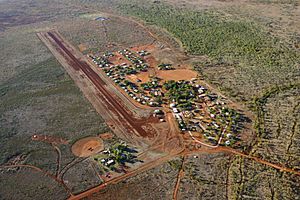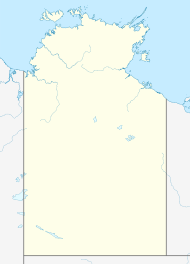Lajamanu, Northern Territory facts for kids
Quick facts for kids LajamanuNorthern Territory |
|||||||||||||||
|---|---|---|---|---|---|---|---|---|---|---|---|---|---|---|---|

Aerial view of Lajamanu and its airstrip
|
|||||||||||||||
| Population | 606 (2016 census) | ||||||||||||||
| Elevation | 316 m (1,037 ft)(airport) | ||||||||||||||
| Time zone | ACST (UTC+9:30) | ||||||||||||||
| Territory electorate(s) | Gwoja | ||||||||||||||
| Federal Division(s) | Lingiari | ||||||||||||||
|
|||||||||||||||
|
|||||||||||||||
| Footnotes | Adjoining localities | ||||||||||||||
Lajamanu is a small town in Australia's Northern Territory. It used to be called Hooker Creek Native Settlement or just Hooker Creek. The town is quite far from big cities. It is about 560 km (350 mi) from Katherine and 890 km (550 mi) from Darwin. In 2016, Lajamanu had about 600 people living there. Most of them (nearly 90%) are Aboriginal and/or Torres Strait Islander people, mainly from the Warlpiri group.
Contents
History of Lajamanu
Lajamanu was started in 1949. The government wanted Warlpiri people to move there from Yuendumu. It took four tries to get people to stay, as they kept walking back to their own communities. In the 1950s, it was known as the Hooker Creek Native Settlement.
Community Leadership
The town had a local council as early as the 1960s. In 1970, a council of twelve men was chosen. One important leader was Maurice Jupurrurla Luther MBE. He had moved to Hooker Creek from Yuendumu in 1958.
In 1976, Maurice Luther helped look into the role of the National Aboriginal Consultative Committee. He was also very important in talks that allowed the Warlpiri people to keep living in Lajamanu. This was after the Gurindji strike, a big event where the Gurindji people got their land back at Wattie Creek. The Gurindji are the traditional owners of the Lajamanu area. Maurice Luther also played a key role in changing the town's name to Lajamanu. This new name comes from a nearby Gurindji place name.
Recent Events
In November 2021, the community had health rules put in place by the Northern Territory Government. This happened during the COVID-19 pandemic in Australia when many people in the Katherine area became sick. The first case of COVID-19 in Lajamanu was found on December 1st.
Getting to Lajamanu
Lajamanu is located about 560 km (350 mi) south-west of Katherine. It is around 890 km (550 mi) from Darwin. The closest community is Daguragu, which is about 110 km (68 mi) away.
It can be hard to get to Lajamanu because it is far from major cities. You can drive there using the Victoria Highway. Then you turn onto the Buntine Highway and finally a dirt road that is usually in good condition.
Lajamanu also has Hooker Creek Airport. It has a paved runway. This airport is used for special flights, by the RAAF (Australia's air force), and by the Flying Doctor service. The Flying Doctor service helps people in remote areas with medical needs.
People and Language
In 2016, 606 people lived in Lajamanu. Most of them are Indigenous, mainly Warlpiri people. This number was a bit lower than in 2006, when 669 people lived there.
Warlpiri Language
Most people in Lajamanu speak Warlpiri as their main language. From 1982 to 2008, Lajamanu School taught in both Warlpiri and English. But in 2008, the Northern Territory Government changed its rules. They said that Warlpiri could not be taught for the first four hours of each school day. After this, fewer students attended Lajamanu School.
Today, many young people in Lajamanu speak a language called "Light Warlpiri" as their first language. This is a newer form of Warlpiri. However, most official business and school lessons are done in English.
Climate and Unique Events
Lajamanu is near the center of Australia. This means it has a very hot and dry climate.
Fish Rain Mystery
In February 2010 and February 2023, news reports said that hundreds of live spangled perch fish rained down on the town! However, scientists say these fish, called Leiopotherapon unicolor, are very good at moving across land. They can travel through water that flows over the ground after heavy rain. So, it's likely that the fish were found on the ground after big storms, making people think they fell from the sky.
| Climate data for Lajamanu Airport, elevation 316 m (1,037 ft), (1998–2020 normals, extremes 1967–present) | |||||||||||||
|---|---|---|---|---|---|---|---|---|---|---|---|---|---|
| Month | Jan | Feb | Mar | Apr | May | Jun | Jul | Aug | Sep | Oct | Nov | Dec | Year |
| Record high °C (°F) | 46.2 (115.2) |
45.5 (113.9) |
44.1 (111.4) |
40.7 (105.3) |
38.8 (101.8) |
36.6 (97.9) |
35.4 (95.7) |
37.8 (100.0) |
41.5 (106.7) |
43.6 (110.5) |
44.8 (112.6) |
46.6 (115.9) |
46.6 (115.9) |
| Mean daily maximum °C (°F) | 37.4 (99.3) |
36.6 (97.9) |
35.7 (96.3) |
34.3 (93.7) |
29.9 (85.8) |
26.8 (80.2) |
27.5 (81.5) |
29.8 (85.6) |
35.1 (95.2) |
37.6 (99.7) |
38.8 (101.8) |
38.3 (100.9) |
34.0 (93.2) |
| Mean daily minimum °C (°F) | 24.2 (75.6) |
23.6 (74.5) |
22.5 (72.5) |
18.5 (65.3) |
13.6 (56.5) |
10.0 (50.0) |
9.7 (49.5) |
10.8 (51.4) |
16.9 (62.4) |
20.8 (69.4) |
23.5 (74.3) |
24.4 (75.9) |
18.2 (64.8) |
| Record low °C (°F) | 17.2 (63.0) |
16.0 (60.8) |
12.9 (55.2) |
8.4 (47.1) |
2.5 (36.5) |
−0.1 (31.8) |
0.0 (32.0) |
1.5 (34.7) |
5.0 (41.0) |
9.0 (48.2) |
12.4 (54.3) |
14.0 (57.2) |
−0.1 (31.8) |
| Average rainfall mm (inches) | 178.9 (7.04) |
177.6 (6.99) |
79.7 (3.14) |
20.3 (0.80) |
7.7 (0.30) |
5.2 (0.20) |
2.3 (0.09) |
1.0 (0.04) |
4.1 (0.16) |
21.1 (0.83) |
36.2 (1.43) |
101.8 (4.01) |
635.9 (25.03) |
| Average rainy days (≥ 1.0 mm) | 9.4 | 9.3 | 5.5 | 1.4 | 1.1 | 0.6 | 0.3 | 0.3 | 0.6 | 2.6 | 4.1 | 7.9 | 43.1 |
| Source: Australian Bureau of Meteorology | |||||||||||||
Art and Culture
The Warlpiri people have a long history of making art. They used to create art on wooden objects, their bodies, the ground, and rocks. Warlpiri art was important for ceremonies and for teaching stories and traditions.
Warnayaka Art Gallery
In 1986, artists in Lajamanu started using canvas and acrylic paint. Today, they continue to paint at the community's Warnayaka Art Gallery. This gallery is run by a board made entirely of Warlpiri people. Many talented artists have painted there, including Peggy Rockman Napaljarri, Lily Nungarrayi Yirringali Jurrah Hargraves, Rosie Murnku Marnku Napurrurla Tasman, and Molly Napurrurla Tasman.
Other famous Indigenous Australian artists from the Lajamanu area include Sheila Brown Napaljarri and Peggy Rockman Napaljarri. Lajamanu artists have also been finalists in the Telstra National Aboriginal and Torres Strait Islander Art Awards several times. This is a very important art competition in Australia.
Notable People from Lajamanu
- Telaya Blacksmith is an athlete.
- Maurice Jupurrurla Luther MBE (born around 1945–1985) was an important community leader, as mentioned in the History section.
- In 2010, Warlpiri elders from Lajamanu, including Bill Bunter, Sharon Anderson, and Martin Johnson, were part of an ABC TV show called Bush Law. This show looked at how traditional Warlpiri law works alongside the main Australian justice system.
- Liam Patrick is an Australian rules footballer.
- Steve Jampijinpa Patrick (also known as Wanta Jampijinpa Pawu-Kurlpurlurnu) is an educator. He has also been involved in the Milpirri festival and worked with the Tracks Dance company. In 2008, he helped write a research paper about working with Warlpiri people. From 2012 to 2014, Wanta worked as a researcher at the Australian National University. In 2013, he wrote and directed a TV show called Milpirri: Winds of Change. This film shows Wanta and the Lajamanu elders' ideas for keeping Warlpiri culture alive in the modern world. The film was shown on NITV and is available to watch online.


